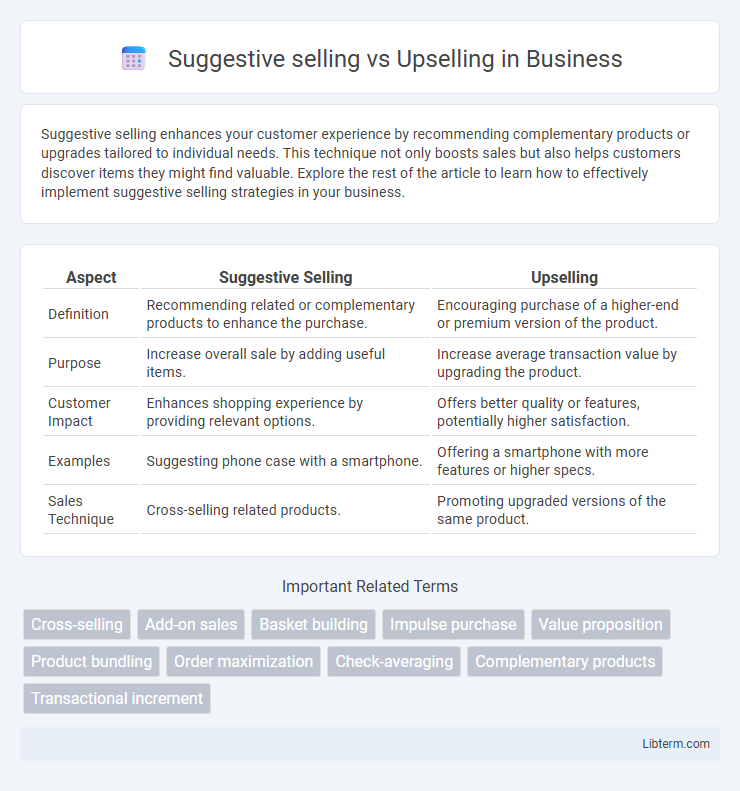Suggestive selling enhances your customer experience by recommending complementary products or upgrades tailored to individual needs. This technique not only boosts sales but also helps customers discover items they might find valuable. Explore the rest of the article to learn how to effectively implement suggestive selling strategies in your business.
Table of Comparison
| Aspect | Suggestive Selling | Upselling |
|---|---|---|
| Definition | Recommending related or complementary products to enhance the purchase. | Encouraging purchase of a higher-end or premium version of the product. |
| Purpose | Increase overall sale by adding useful items. | Increase average transaction value by upgrading the product. |
| Customer Impact | Enhances shopping experience by providing relevant options. | Offers better quality or features, potentially higher satisfaction. |
| Examples | Suggesting phone case with a smartphone. | Offering a smartphone with more features or higher specs. |
| Sales Technique | Cross-selling related products. | Promoting upgraded versions of the same product. |
Understanding Suggestive Selling
Suggestive selling involves recommending complementary or related products to enhance the customer's original purchase, increasing overall satisfaction and basket size. This technique relies on understanding customer needs and preferences to offer relevant product suggestions, effectively boosting sales without pressuring the buyer. Businesses employing suggestive selling can improve customer experience and maximize revenue by strategically positioning add-on items during the sales process.
Defining Upselling Techniques
Upselling techniques involve encouraging customers to purchase a higher-end or more expensive version of a product or service they are considering, often by highlighting enhanced features, added value, or premium benefits. Common methods include bundling complementary products, offering extended warranties, and presenting limited-time discounts on upgraded options. These strategies aim to increase the average transaction value while improving customer satisfaction through perceived better quality or functionality.
Key Differences Between Suggestive Selling and Upselling
Suggestive selling involves recommending complementary products or services to enhance the customer's original purchase, while upselling encourages customers to buy a higher-end or more expensive version of the same product. Key differences include the objective: suggestive selling aims to increase the overall cart value by adding related items, whereas upselling focuses on increasing the sale value of a single item. Additionally, suggestive selling often improves customer satisfaction by offering useful add-ons, while upselling targets maximizing revenue from the best product tier.
Psychological Triggers in Suggestive Selling
Suggestive selling leverages psychological triggers such as social proof, scarcity, and reciprocity to subtly influence purchasing decisions by enhancing perceived value and urgency. Techniques like highlighting popular items activate customers' desire to conform and fear of missing out (FOMO), driving impulse buys. Upselling, in contrast, focuses more on increasing the transaction value by presenting superior or premium options, relying less on emotional triggers and more on logical justification.
Effective Upselling Strategies for Businesses
Effective upselling strategies for businesses involve identifying customer needs and presenting premium product options that enhance the original purchase value, thereby increasing revenue per transaction. Using data-driven insights to personalize recommendations ensures that upsell offers align with customer preferences and improve satisfaction. Training sales teams to highlight benefits and value rather than just price helps convert suggestive selling opportunities into higher-value sales through confident, targeted communication.
Benefits of Suggestive Selling in Retail
Suggestive selling in retail enhances the customer experience by offering personalized product recommendations that increase basket size and boost overall sales revenue. This technique helps retailers build stronger customer relationships through tailored suggestions, leading to higher satisfaction and repeat business. Unlike upselling, which focuses on encouraging customers to purchase a more expensive version, suggestive selling subtly introduces complementary or related items, optimizing the shopping journey and maximizing profit.
Upselling: Impact on Customer Experience
Upselling enhances customer experience by offering higher-value alternatives that better meet customer needs, increasing satisfaction and perceived value. It encourages customers to explore premium products or features, often leading to increased loyalty and a more personalized buying journey. Effective upselling relies on understanding customer preferences and delivering relevant recommendations without pressure, ensuring a positive and seamless interaction.
Common Mistakes in Suggestive Selling and Upselling
Common mistakes in suggestive selling and upselling include failing to personalize recommendations based on customer needs and preferences, which can result in a pushy or irrelevant sales approach that diminishes customer trust. Overloading customers with too many options or aggressive tactics often leads to decision paralysis or rejection of additional purchases. Misunderstanding product knowledge or lacking empathy during interactions decreases the effectiveness of upselling and suggestive selling strategies, negatively impacting conversion rates and customer satisfaction.
Training Your Team for Sales Success
Effective training for suggestive selling and upselling emphasizes understanding customer needs and product knowledge to tailor recommendations that maximize value and satisfaction. Role-playing scenarios and data-driven feedback enhance team confidence, enabling personalized offers that increase average transaction value. Consistent practice and performance tracking empower sales teams to refine techniques, ultimately driving revenue growth and customer loyalty.
Measuring the ROI of Suggestive Selling vs Upselling
Measuring the ROI of suggestive selling versus upselling involves analyzing key performance indicators such as average transaction value, conversion rates, and customer retention. Suggestive selling typically drives incremental revenue by recommending complementary products, increasing order size and enhancing customer satisfaction. Upselling focuses on higher-margin products or premium versions, impacting revenue growth and profit margins more significantly but requires precise tracking of sales lift and customer lifetime value to evaluate effectiveness.
Suggestive selling Infographic

 libterm.com
libterm.com